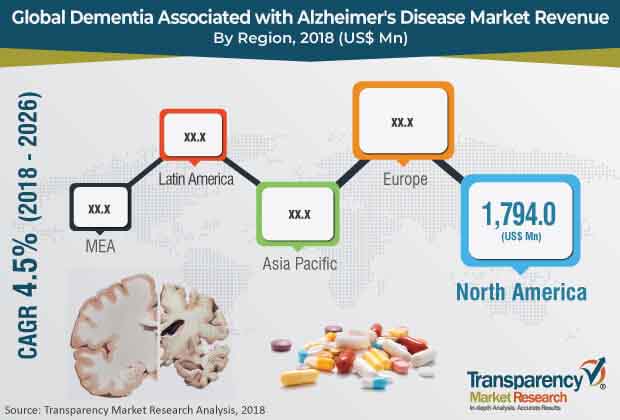Transparency Market Research (TMR) has published a new report titled, “Dementia Associated with Alzheimer’s Disease Market – Global Industry Analysis, Size, Share, Growth, Trends, and Forecast, 2018–2026”. According to the report, the dementia associated with Alzheimer’s disease market was valued at US$ 4,665.1 Mn in 2017. The market is anticipated to reach US$ 6,936.8 Mn by 2026 and expand at a CAGR of 4.5% from 2018 to 2026. Rise in number of old age patients, upcoming novel treatments, and high unmet medical needs are expected to augment the global market from 2018 to 2026. The dementia associated with Alzheimer’s disease market is projected to expand owing to higher investments by companies, demand for better treatments, and developing healthcare infrastructure in various economies.

Growing geriatric population and rising prevalence of Alzheimer’s disease
According to the Alzheimer’s Disease International, nearly 44 million people have Alzheimer’s or a related dementia, worldwide, and is a major reason for disability in later life. Moreover, according to the Alzheimer’s Association, Alzheimer’s is the sixth-leading cause of death in the U.S. and currently, more than 5 million Americans are living with Alzheimer’s. It is estimated that, approximately 16 million Americans would be affected by Alzheimer’s by 2050.
According to WHO, population aging is expected to continue, even accelerate, due to falling fertility rates and remarkable increases in life expectancy. Additionally, the number of people aged 65 or older is projected to rise to nearly 1.5 billion in 2050, with significant increase in developing countries.
For More Details, Request A PDF Brochure Report @ https://www.transparencymarketresearch.com/sample/sample.php?flag=B&rep_id=39203
This sudden shift toward aging of the population is likely to contribute to the increasing prevalence of AD, placing a major burden on individuals, health systems, and social care systems across the world. Rise in incidence of Alzheimer’s is expected to boost the demand for improved drugs and new therapies.
High unmet clinical needs in patients with Alzheimer’s disease
Alzheimer’s is the most common cause of dementia among the geriatric population, leading to their dependency on others in later life. Currently, available treatment options are insufficient, as they primarily focus on symptoms relief. There are no drugs available that can cure, reverse, or halt disease progression. Several patients are unable to find relief through the currently available medicines and continue to suffer in pain; therefore, there is high need for innovative treatment options for AD. However, increasing competition from generic drugs are restraining the market.
High cost of Alzheimer’s disease drug development program
According to journal published on NCBI, total costs of an AD drug development program is estimated at US$ 5.6 Bn, and the process takes 13 years from preclinical studies to approval by the FDA. Moreover, development of disease-modifying treatments for Alzheimer’s disease (AD) faces a number of barriers, including difficulties in identifying appropriate populations for clinical trials, lack of surrogate biomarkers, and the exceptional size and duration of clinical trials. Additionally, complications associated with the progression of disease may delay the development of drug leading to increased cost of drug development program.
Cholinergic/ Cholinesterase (ChE) Inhibitor segment dominates the global market due to its choice as first line of treatment for AD
The cholinergic/ cholinesterase (ChE) Inhibitor segment dominated the market in 2017. It is expected to maintain its position, in terms of market share, during the forecast period. The only FDA approved treatment for Alzheimer’s include donepezil, rivastigmine, and galantamine belonging to cholinergic/ cholinesterase (ChE) inhibitor class, and memantine. Various studies have proven that cholinergic/ cholinesterase (ChE) inhibitor class drugs are mostly prescribed for the treatment of AD worldwide. The combined drugs and other segment is expected to expand at a lower CAGR, as it is less accepted in developed as well as developing countries. Approximately 75% of patients diagnosed with Alzheimer’s disease are in the moderate to severe stage of the disease and yet, only about one-third of these patients are treated with combination therapy; however, clinical studies have proven the superior improvement in patients with AD, as compared to monotherapy.
North America dominates the global market owing to significant funding from government in order to improve quality of life for persons suffering from Alzheimer’s disease
North America is expected to lead the dementia associated with Alzheimer’s disease market, and account for a significant share, by the end of 2026. Increasing prevalence of AD in patients, rising healthcare expenditure, and increasing investments, are key factors that are anticipated to boost the dementia associated with Alzheimer’s disease market in the next few years. The dementia associated with Alzheimer’s disease market in APAC is projected to expand at a notable CAGR due to increasing awareness regarding AD in developing countries and government initiatives introduced in the region.
Investments by key players is driving the dementia associated with Alzheimer’s disease market.
Key players dominating the dementia associated with Alzheimer’s disease market include Merz Pharma GmbH & Co. KGaA., Novartis AG, Allergan plc., Pfizer, Inc., Daiichi Sankyo Company, Limited, Ono Pharmaceutical Co., Ltd, Johnson & Johnson Services, Inc., Eisai Co., Ltd., and H. Lundbeck A/S, and F. Hoffmann-La Roche Ltd.